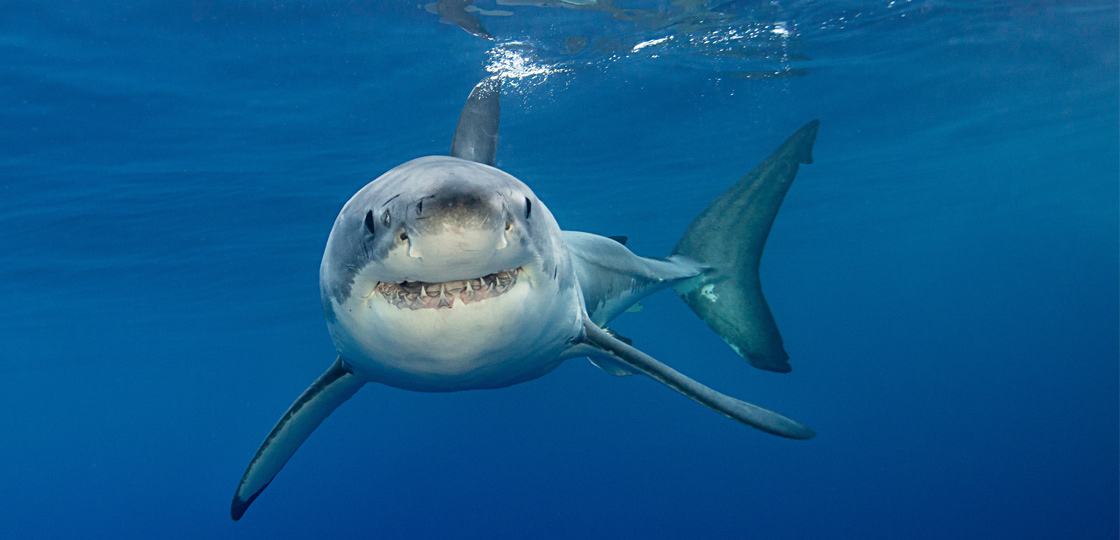Shark

Shark
The shark is one of the most feared sea animals. Scientists classify more than 400 species of fish as sharks. These fish live in oceans throughout the world. But sharks are most common in warm seas.
Some kinds of sharks live in the depths of the ocean. Others are found near the surface. Some species of sharks live in coastal waters. Others dwell far out at sea. A few species enter rivers and lakes that have outlets to the sea. Scientists believe that one species, the Ganges River shark of India and Pakistan, lives only in rivers.
WATCH IT! HOW DANGEROUS ARE SHARKS?
THE BODY OF THE SHARK
Sharks differ from most other kinds of fish in a number of ways. For example, sharks have a boneless skeleton. The skeleton is made of a tough, elastic substance called cartilage. Most species of sharks have a rounded body, shaped somewhat like a torpedo. This streamlined shape helps sharks to swim. Angel sharks have a flat body similar to that of skates and rays. Angel sharks live near the ocean bottom.
Sharks have fewer young at a time than most fish do. Some species give birth to 60 or more pups in a litter. Most sharks, however, have far fewer. The parents do not take care of the young. The mother may even eat the babies.
Shark eggs, unlike those of most fish, are fertilised inside the female’s body. Among most species of sharks, the eggs hatch inside the female. The pups are born alive. At least 40 species lay their eggs outside their bodies.
Scientists have observed a few instances of a female shark giving birth without mating with a male. Such reproduction without mating is called parthenogenesis.
Tail and Fins
Sharks can travel with great bursts of speed when excited. The fastest-swimming sharks have a crescent-shaped tail that provides power for swimming.
Teeth and Scales
A shark’s mouth is on the underside of the head among most species. The exceptions are the angel, megamouth, whale, and wobbegong sharks. The mouth of these sharks is at the front of the head. A shark has several rows of teeth. Some people believe that sharks must turn over on their back to bite, but this is not true.
KINDS OF SHARKS
Sharks belong to a group of fishes known as elasmobranchs. Rays and skates also belong to this group. Scientists do not know exactly how many kinds of sharks there are.
GREAT WHITE SHARK
They live in coastal areas of cool oceans throughout the world. Unlike most other sharks, great white sharks have warm blood and warm muscles. These characteristics make them faster and stronger than most other sharks. Great white sharks have sharp, triangular teeth with jagged edges. They can rip chunks of flesh from seals and sea lions, two of their favourite prey.
Scientists think that great white sharks attack human beings because people look like seals to the sharks. The resemblance is especially great when a person swims at the surface or floats on a surfboard.
Sport and commercial fishing have reduced the number of great white sharks in many parts of the world. Some countries have laws that protect great white sharks.
WATCH IT? GREAT WHITE SHARK FEEDING
HOW MUCH DO YOU KNOW ABOUT SHARKS?
Set off on a webquest to test your knowledge.
Webquest for younger students
Webquest for older students

2023 WORLD BOOK ENCYCLOPEDIA
This year’s Spinescape® was specifically selected because sharks have been a high-interest topic to students K-12, and World Book has a desire to support shark conservation. “There are a lot of misconceptions about sharks out there,” says Tom Evans, World Book’s Editor in Chief. “Sharks have the reputation of attacking human beings. But fewer than 80 shark attacks a year are reported throughout the world,” adds Tom.
Meet Tanya Griffin Houppermans, the internationally acclaimed award-winning photographer, shark naturalist, and scientific diver behind The World Book Encyclopedia spinescape. Known for her breathtaking underwater images, Tanya’s passion for marine education and shark conservation began after learning humans kill an estimated 100 million sharks annually. Against a backdrop of human-wildlife conflict and the ever-present threat of shark finning, her images show that despite their scary reputation, these misunderstood, beautiful, and intelligent creatures desperately need our help.
Learn more about this year’s encyclopedia.
If you’re not a subscriber to World Book Online, try it for free.
RECENT POSTS & TIPS
- Anzac Day
- International Women's Day
- Australian women's rights campaigner Vida Goldstein
- SALE! 2023 WORLD BOOK ENCYCLOPEDIA
- Australian Aboriginal Languages
- Beware the Bunyip
- Shark
- From Bees to Honey
- World Book Wizard has arrived!
- World Book Online: Winners and Finalists at the 2021 EdTech Cool Tech Awards!
- Computer Science
- Help Build Reluctant Readers’ Confidence



